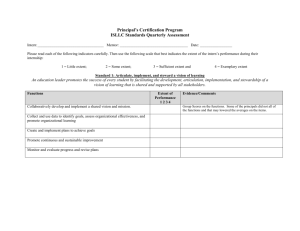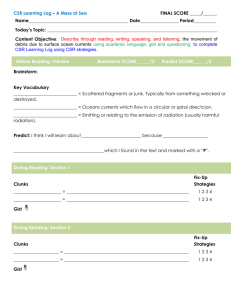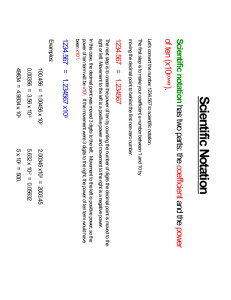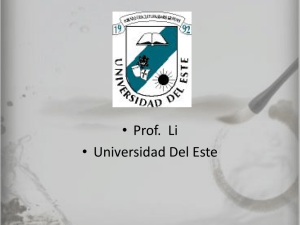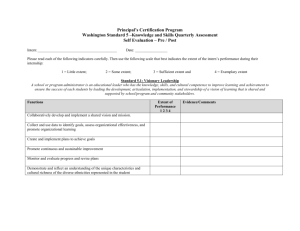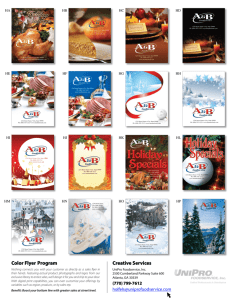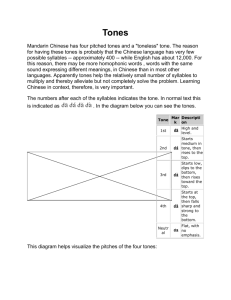中文105 Fall 2007
advertisement
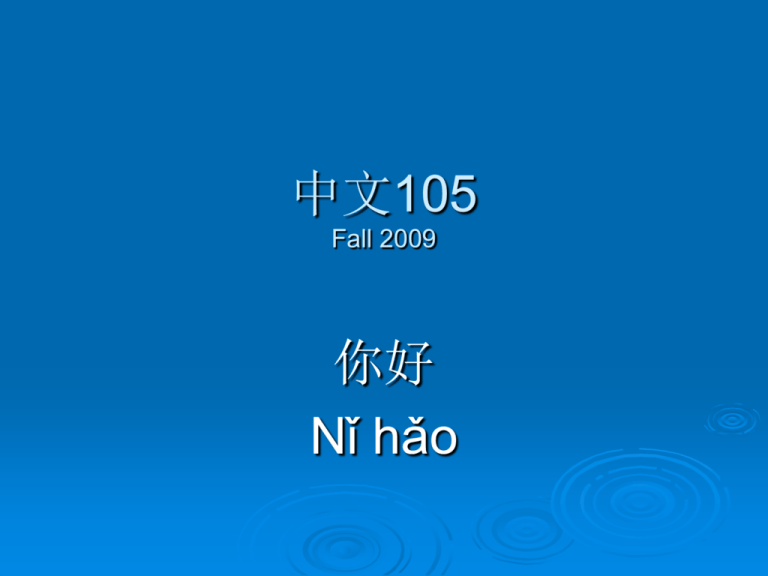
中文105 Fall 2009 你好 Nǐ hǎo 1.介绍(Introduction) My name…董治音 (Dong3 zhi4 yin1) (董老师 Dong3 lao3 shi1: teacher Dong) The course.. How is the course taught? Questions? Your Chinese names.. What do you know about the language that we call “Chinese”? 1.What do you know about Chinese (mandarin) as a language? Phonetics Morphology? Syntax (Grammar) Dialects Orthography: The Characters Now, some Chinese ! Ni3 hao A-Ni3 hao! B-Ni3 hao! A-Wo3 shi4 …. B-Wo3 shi4… A-Xin4 hui4 B-Xin4 hui4! Zai4 jian4 A-Zai4 jian! 1.Classroom Expressions… Zài jiàn-Good bye Xiè xiè-thank you Hěn hǎo-very good Nǐ hǎo-hello 1.The Three Parts of The “Chinese alphabet”-Pinyin First, A new classroom expression: Qǐng gēn wǒ niàn: read after me Initials: Consonants and consonant clusters Finals: Vowel and vowel combinations. Tones: Chinese is a tonal language! Let’s look at an example: Nǐ hǎo 1-2.Syllable, Word, and Character One or more syllables make a word: Each syllable has a Chinese character Tone initial Nǐ 你 final hǎo 好 2.The Pinyin Chart Finals a o e ê 1234 e 1234 (ê) -i er ai 234 er 1234 ai ei ao ou an en ang eng 1234 ao 1 34 ou 1 34 an 14 en 12 4 ang 1 34 ban 1 34 ben 1 34 bang 1234 beng Initials 1234 a b 1234 ba p 12 4 pa m 1234 ma 1234 bo 1234 mo 1234 bai 1 34 bei 1234 bao 1234 po 1234 pai 12 4 pei 1234 pao 1 pou 12 4 pan 12 4 pen 1234 pang 1234 peng me 234 mai 234 mei 1234 mao 23 mou 1234 man 12 4 men 23 mang 1234 meng 2.The Finals a, e, u, o, i, ü 2.The Initials-Part I b d g p t k m n h f l 3.The Initials-Part II j z zh q x c s ch sh r The Initials Song B,p,m,f d,t,n,l G is the brother of k and h J as in jeep, q is like cheese, X means “west” In Chinese Z c s silk we all like, Zh ch sh r run really fast. 3.The Tones 3.Practice! Mā má mǎ mà Dī dí dǐ dì Gē gé gě gè 4.Classroom Expressions shī hǎo Hello Teacher Xiè xie Thank you Bú kè qi You are welcome Lǎo 4.The Compound Finals-Part I 1. ai 2. An 3. Ia in ei ao ou en ang eng ong iao ie iu ia iang ing iong 4.Our First Tongue Twister! Sì he shí 四和十 Sì shì sì, 四是四 Shí shì shí 十是十 Shísì shì shí sì, 十四是十四 Sì shí shì sì shí. 四十是四十 Four is four Ten is ten. Fourteen is fourteen, Forty is forty. 4-5.Let’s review and do some practice sing the song one more time! Compound finals-part I flashcards Initials-let’s 5.The Compound Finals-Part II 1. ua uan 2. üe 3. er uo un üan uai ui uang ueng ün 5.Tone Sandhi New classroom expression: Qing3 wen4 Two or more third tones = second + third Two fourth tones = fourth + neutral third tone + Any tone= half third tone + any tone A Game! Pinyin 举示 6. Spelling rules First some classroom expression: Qǐng wèn When there is no intials before finals starting with u, w shall be added as initial. For example: u - wu If there is other vowels after u, u shall be changed to w. For example: ua – wa uo –wo uai –wai uei – wei When there is no intials before finals starting with i, y shall be added as initial. For example: in –yin ing -ying If there is other vowels after i, i shall be changed to y. For example: ia – ya ie –ye iao –yao iou –you 6. Spelling rules When there is no intials before finals starting with ü, y shall be added as initial no matter if there is vowels after ü. When y added, ü is changed to u. For example: ü – yu üe – yue üan – yuan ün –yun When initials other than n and l proceed finals ü starting with, ü changes to u. nü – nü lü – lü jü – ju qü - qu Practice Yan Ian uan wan yi i Xu Xü 6. Where to mark the tones? The tone mark is placed over the vowel if there is only one vowel letter. bù nà tè If there are two vowels, the tone mark is placed on the first, unless the this first vowel is i or u. kǎi hēi qiú tuī Qióng zhuāng chuán When the tone mark is place on i, the small dot is removed. yí lín huī 6.Classroom Expressions and L1 New words bù qǐ Sorry, excuse me Méi guān xi It’s O.K. How do you ask questions? Nǐ hǎo mā How are you? Wǒ hěn hǎo ! I am good. Let’s greet each other this way! Let’s practice on L1 D1 new words.. Duī Another Game 写拼音比赛:男生组女生组 The Characters 中国字 The origin and categories of Characters Basic radicals Stroke order Basic strokes Let’s practice! Your homework( a lot of it): The origin of Chinese Characters The earliest Chinese characters were found on the “Oracle bones” (turtle shells) Chinese written system evolved over the years and developed many different styles Categories of Modern Chinese Characters Pictographic Self-explanatory Associative compounds Categories of Modern Chinese Characters Pictophonetic 洋 妈 饭 钢 Mutually explanatory 老 考 Phonetic loan 来 我 Radicals Radicals are basic and meaningful components of Chinese characters. Knowing them well will greatly facilitates your understanding of the characters 你 好 Basic Strokes There are a total of eleven basic strokes that in combination form Chinese characters. Each of them should be written in a particular way The stroke orders 1. Top before bottom 2. Left before right 3. Left vertical stroke (usually) before top horizontal stroke 4. Bottom horizontal stroke last 5. Center stroke before wings 6. Horizontal strokes before intersecting vertical strokes 7. Left-falling strokes before right-falling srokes A final rule can contradict the others: 8. Minor strokes (often) last Despite these conflicts between rules most students quickly acquire a natural feel for the proper stroke order. ` Lesson 1 New Words Let’s write some of the new words from Lesson 1, and pay attention to the structures and radicals of these words 小姐 请问 您 贵姓 名字 我 Practice Quiz I. 1) 3) 5) 7) 9) 11) 13) 15) Circle the sound you heard: b p 2) d g k 4) j x t 6) m n l 8) zh z c 10) l ch c 12) z s sh 14) j c z t q f sh h zh g Practice Quiz II Circle the sound you heard and mark the tones: 1)xi 3)za 5)si 7)xin 9)qi shi ja xi jin chi 2) 4) 6) 8) 10) ri zhen ge chan sha li chen he shan zha
